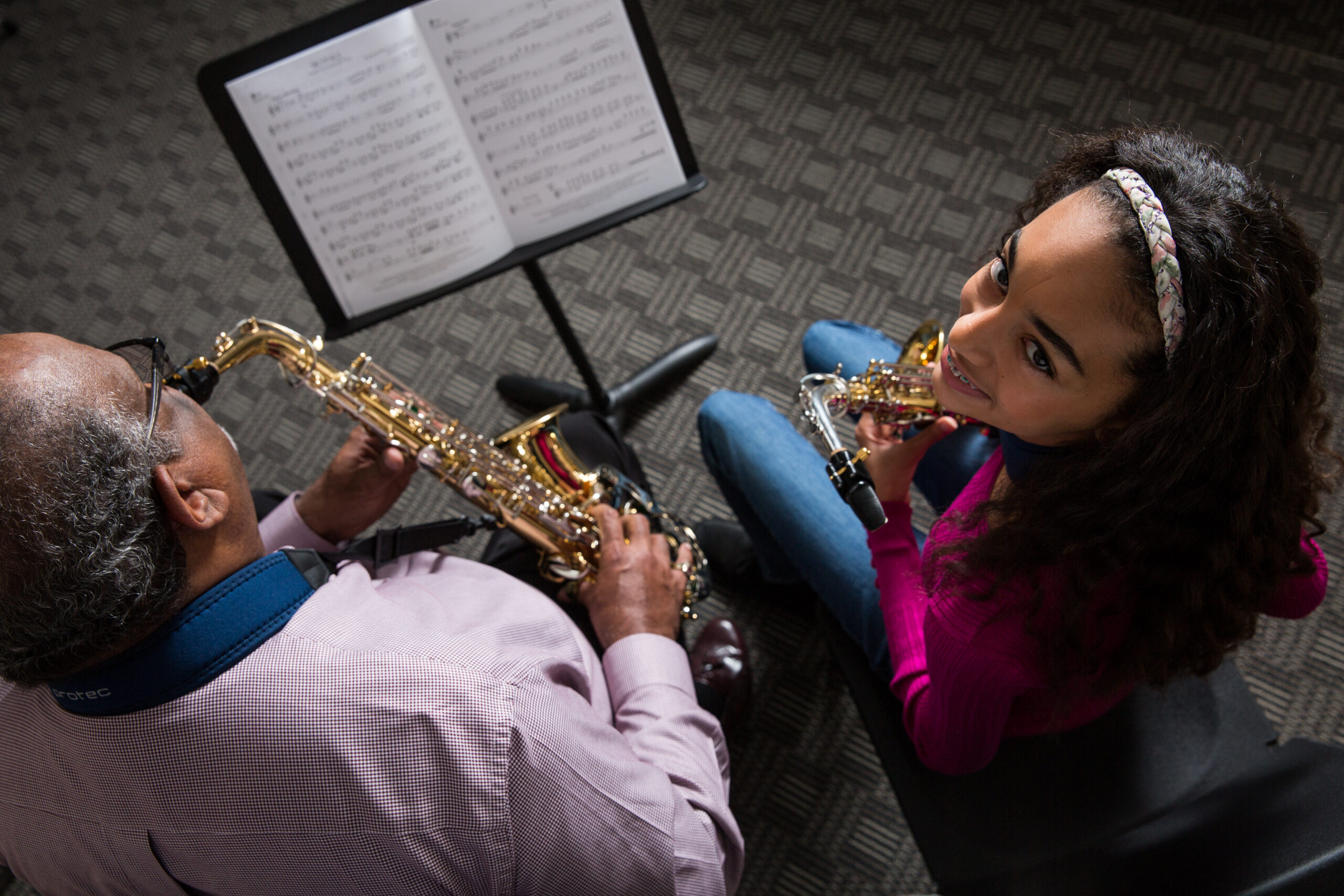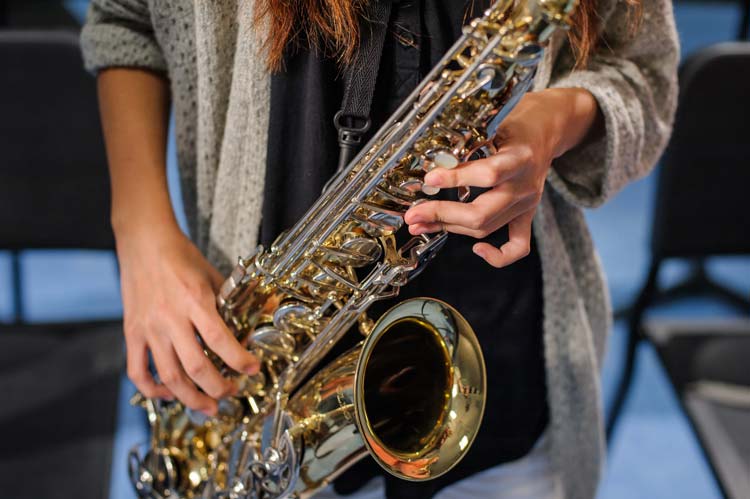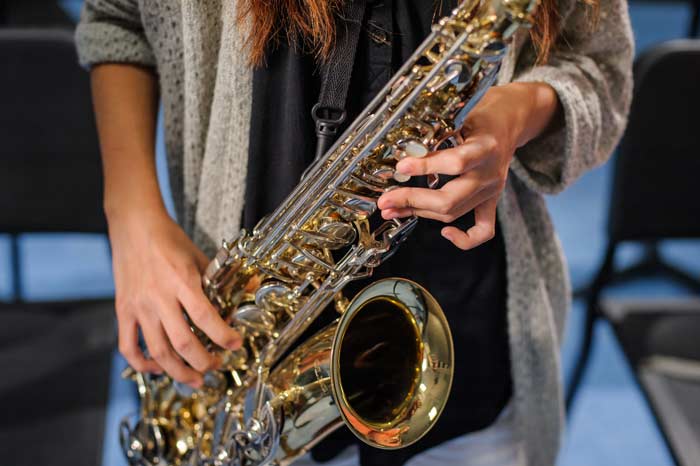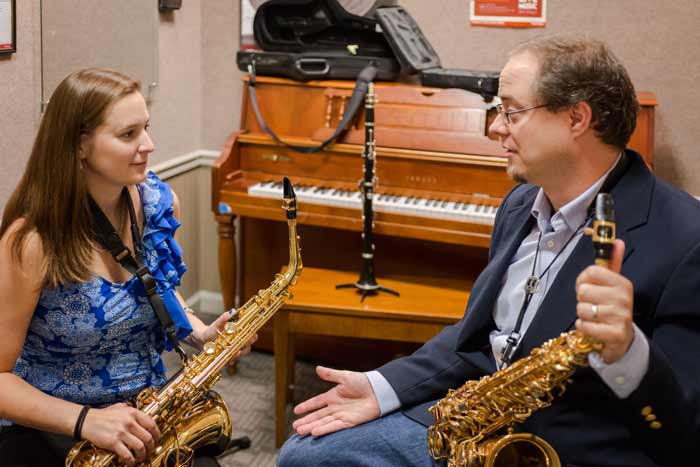October 05, 2015
Saxophone Embouchure: Tips for Beginners


In its simplest terms, embouchure means what you do with your mouth; therefore, saxophone embouchure is what you do with your mouth while playing the saxophone. If you’re new to playing the saxophone, learning and perfecting the proper embouchure is one of the most complicated facets of mastering the instrument. Although there is more than one correct embouchure, each type of saxophone embouchure suits different players and playing styles. As a result, most saxophone players tend to stick with one type of embouchure while playing.
Forward with Downward Pressure
Regardless of the type of embouchure you’re taught and/or ultimately choose, the saxophone embouchure should be thought of as being “forward with downward pressure.” Some saxophonists make the mistake of opting for a formation that’s tightly pulled back with lots of pressure exerted by the lower teeth and jaw. If you look like you’re smiling while you play the saxophone, your embouchure style can (and should!) be improved.
This formation actually hinders the vibration of the reed, causing a poor tone and constant “zing” in the sound produced. From mouthpiece position and embouchure corners to alignment of the upper and lower teeth, we’ll go over a few key components of proper saxophone embouchure. Keep the below in mind while practicing and performing and you’ll be well on your way to proper embouchure.
Embouchure and the Mouthpiece
If the embouchure makes contact with the mouthpiece at the point at which the reed and mouthpiece rails meet, you’re on the right track. If you need help finding this contact point, here’s a trick:
- insert a piece of paper between the reed and mouthpiece
- push the paper downward until it stops
- mark this position with a pencil
- pull the paper out
- form the embouchure at the point marked by the pencil
Once the correct contact point has been reached, you should notice a fuller sound. Eventually you’ll find this place on your own, but until you get the hang of playing the saxophone, keep a paper and pencil handy just in case.
Embouchure Corners
As previously mentioned, the corners of the embouchure should not be pulled back as if you’re smiling. Instead, they should be focused inward, as this formation provides sufficient support to the upper and lower lips, allowing for maximum vibration of the reed. If your corners are too tight, the reed vibration will be blocked. In some cases, the sound can even be cut off completely. If you’re having trouble with the embouchure corners, a good exercise is to whistle and take notice of the way the corners of your lips pucker. You can also mimic the action of sucking a thick milkshake through a straw or say “oooh”. The best thing about these exercises is they can be done anywhere- if you’re bored at school or on the couch at home, whistle and take notice.
Jaw Alignment
Once you’ve mastered the above, the next thing to consider is the alignment of your jaw. For most of us, the natural alignment of our jaw is that of a slight overbite, particularly if you’ve worn braces at one point in your life. Although this is true for the majority of the population, some people have naturally occurring underbites. Unfortunately, people with severe underbites may have trouble forming proper embouchure. For the purpose of playing the saxophone, saxophonists should strive to have an even jaw alignment- one where there is neither an overbite nor an underbite. In most cases, this will require that you push your lower jaw forward, ever so slightly, until your lower teeth match up with your upper teeth.
The Single Lip Embouchure
Although there are a few different embouchure styles, the single lip embouchure is the most popular and most prominently taught embouchure in the United States. It’s normally used in concert and marching bands, in addition to classical music, which explains its popularity. This embouchure involves tucking your bottom teeth under your lower lip until your teeth are covered. Once this is accomplished, close your lips. Next, put the mouthpiece in your mouth and form an airtight seal all the way around by pressing the corners of your mouth and your top lip against the mouthpiece. Throughout this process make sure you’re using your lips to make the seal instead of biting down on the mouthpiece. It’ll be difficult at first, but you’ll eventually build up muscles in your lips.
Note: double lip embouchure is similar to the above except you tuck your top teeth under your top lip, too.
Pay Attention to Your Lower Teeth
Many new saxophone players develop the same bad habit early on- the habit of biting into their lower lip with their lower teeth. Many falsely assume that the lower lip is a cushion into which their teeth can bite, but this habit results in a hindrance of the reed vibration, not to mention the fatigue and pain caused by the lower teeth actually restricting blood flow to the lip. As a good rule of thumb, remember that the lower teeth should never touch anything. They should be as far away from the mouthpiece as possible at all times. This will keep the oral cavity open and free from restriction. If your chin muscles aren’t strong enough to support the lower lip, see the exercises below.
Strengthening Exercises
Strengthening the embouchure muscles can be tough, especially for new saxophonists. Fortunately, there are a few easy exercises that can help build up strength. First, casually close the jaw, allowing the bottom and top teeth to make contact, just don’t clamp the jaw shut during this exercise. Then, push the upper and lower lips tightly against each other, maintaining a straight line with your lips. Hold this position for five seconds and gradually increase to ten or fifteen seconds over time. For the second exercise, start by keeping your teeth together and slowly open the jaw while keeping your lips closed. Open your jaw as far as you can while keeping your lips closed, and hold this position for a set amount of time. Just like with weight lifting, these strengthening exercises should be performed frequently, or any progress will be lost.
If you’re new to playing the saxophone, you might need some info about reeds and mouthpieces. Check out our Saxophone Mouthpiece Buying Guide and Choosing a Saxophone Reed.







